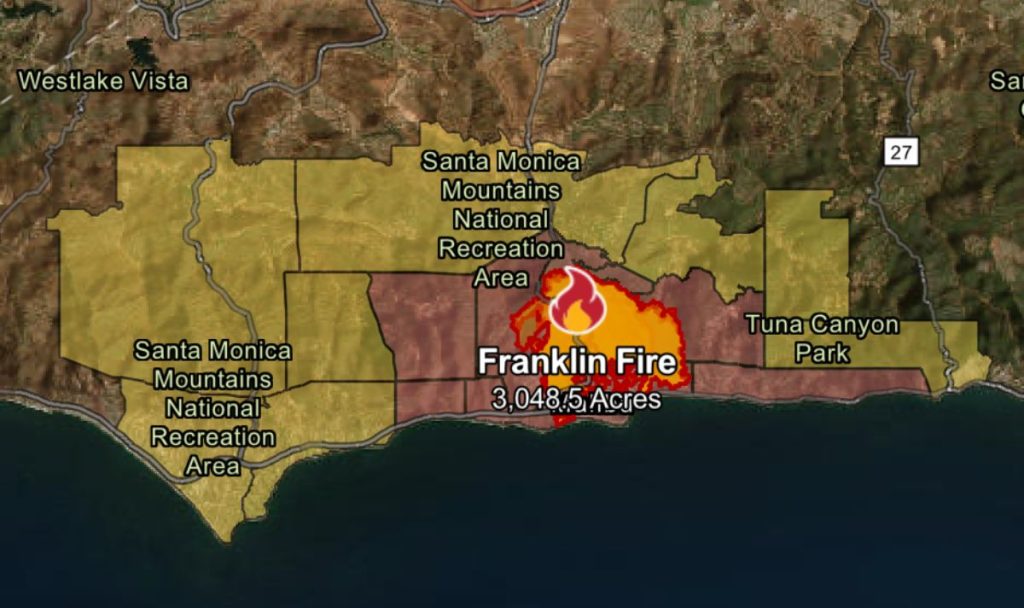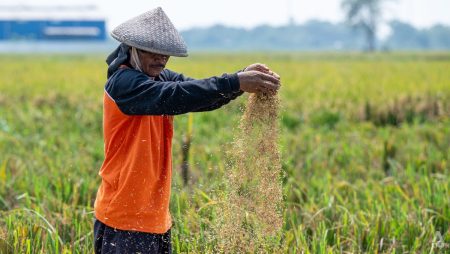The Franklin Fire, a rapidly spreading wildfire, has ignited the rugged terrain of Malibu, California, prompting widespread evacuations and a massive firefighting effort. The blaze, which began late Monday night along Malibu Canyon Road near Pepperdine University, has consumed over 3,049 acres, fueled by strong Santa Ana winds and low humidity. These dry, gusty conditions have created a challenging environment for the 1,500 firefighters battling the flames, hindering containment efforts and allowing the fire to spread quickly through dense vegetation. The fire’s aggressive advance has spurred mandatory evacuations for approximately 6,000 residents and placed thousands more under evacuation warnings, impacting over 8,000 structures. Early assessments indicate at least seven structures have been destroyed and eight damaged, highlighting the destructive power of the rapidly moving flames.
The dramatic scenes unfolding in Malibu paint a vivid picture of the fire’s intensity. Social media platforms are flooded with images and videos showcasing the fire’s relentless march, with flames leaping between trees, sparks showering down roads, and residents desperately trying to protect their homes with whatever resources are available, including water from swimming pools. The fire’s proximity to Pepperdine University led to a shelter-in-place order for students, though preliminary assessments indicate minimal damage to campus structures. The ongoing firefighting efforts, hampered by difficult terrain and persistent winds, continue through the night as crews strive to establish containment lines and protect properties in the fire’s path.
The Santa Ana winds, a recurring weather phenomenon in Southern California, play a significant role in the Franklin Fire’s rapid growth. These downslope winds originate in the high-pressure system over the Great Basin, pushing dry air towards the coast. As the air descends and compresses, it warms and dries further, creating ideal conditions for wildfires to ignite and spread rapidly. The low humidity levels exacerbate the situation, making vegetation even more susceptible to burning. These factors combined have created a perfect storm for the Franklin Fire, transforming it into a significant threat to the Malibu community. While the precise cause of the fire remains under investigation, the combination of dry vegetation, strong winds, and low humidity has undoubtedly contributed to its rapid escalation.
The mandatory evacuation orders cover areas south of Piuma Road, north of the Pacific Ocean coastline, east of Puerco Canyon Road/Corral Canyon Park, and west of Los Flores Canyon Road, as well as the area between the Pacific Ocean coastline and Tuna Canyon Park to the west of Tuna Canyon Road. These evacuations underscore the serious threat posed by the Franklin Fire and the need for residents to prioritize their safety. Among those forced to evacuate are several high-profile individuals with homes in Malibu, including actor Dick Van Dyke and singer Cher, highlighting the fire’s widespread impact on the community. The evacuation warnings extending to surrounding areas reflect the potential for the fire to spread further, emphasizing the importance of preparedness and vigilance among residents.
The firefighting effort involves a coordinated response from various agencies, including the California Department of Forestry and Fire Protection (Calfire) and the Los Angeles County Fire Department. The challenging terrain, coupled with the strong winds and low humidity, complicates firefighting operations, making it difficult to access and contain the blaze. Firefighters are utilizing a variety of tactics, including ground crews working to establish firebreaks and aerial resources dropping water and retardant to slow the fire’s progression. The ongoing assessment of the fire’s behavior and the potential for further growth will guide future strategies and determine the extent of resources required to bring the Franklin Fire under control.
The Franklin Fire serves as a stark reminder of the increasing threat of wildfires in California, driven by climate change and prolonged periods of drought. These conditions create a tinderbox-like environment, increasing the frequency and intensity of wildfires across the state. The ongoing efforts to protect lives and property in Malibu underscore the importance of proactive fire prevention measures, community preparedness, and rapid response strategies. As firefighters continue their relentless battle against the Franklin Fire, the community rallies together, demonstrating resilience and a shared commitment to overcoming this devastating event.










